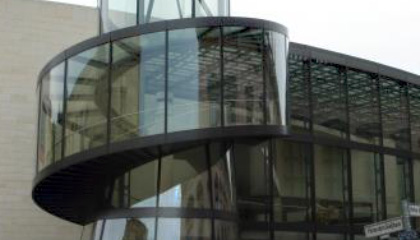In the world of modern architecture, one material stands out for its unmatched strength, durability, and versatility: toughened glass.
Unlike conventional glass, toughened glass undergoes a special heating and rapid cooling process that enhances its physical properties, making it more resistant to breakage and thermal stress. This article delves into the benefits and uses of toughened glass in contemporary architecture, exploring how it has revolutionized the industry. From awe-inspiring glass facades that shimmer in the sunlight to sleek and minimalistic interior partitions, toughened glass offers endless creative possibilities for architects and designers. With its remarkable strength, toughened glass allows for larger and more expansive windows, offering breathtaking views and ample natural lighting while maintaining structural integrity. Its resistance to thermal stress makes it an ideal choice for buildings in extreme climates, where temperature fluctuations can put immense strain on conventional materials. Moreover, toughened glass is also used in safety applications, such as balustrades, doors, and shower screens, offering added security without compromising on aesthetics. Its ability to withstand high impact makes it a reliable choice for areas prone to accidents or vandalism. In this article, we delve deeper into the world of toughened glass, exploring its uses, benefits, and how it continues to shape the landscape of modern architecture.
Definition and Introduction of Toughened Glass
Toughened glass, also known as tempered glass, undergoes controlled thermal treatment to significantly increase its strength. Initially, it starts as annealed glass, which is then heated to approximately 650°C and rapidly cooled. This process makes toughened glass approximately four times stronger than ordinary glass. The treatment results in compressive stress on the surface and improved bending strength. It’s a safety glass that shatters into small, harmless pieces upon breakage, making it ideal for various applications.
Advantages of Toughened Glass
- Strength and Durability
- Toughened glass is significantly stronger than regular annealed glass. It can withstand greater impact forces without breaking.
- Its durability makes it suitable for various applications, from architectural structures to automotive windows.
- Safety
- When toughened glass breaks, it disintegrates into small, pebble-like fragments rather than sharp shards. This minimizes the risk of injury.
- For safety-critical areas like doors, windows, and shower enclosures, toughened glass is an excellent choice.
- Thermal Resistance
- Toughened glass can handle high temperatures, making it suitable for applications where exposure to heat or fire is a concern.
- It remains stable even at temperatures up to 250°C, which is essential for safety in fire-resistant designs.
- Edge Strength
- The edges of toughened glass are particularly strong. This property is crucial for applications like spider glazing (where glass panels are held by metal brackets) and point-fixed glazing (using bolts or clamps).
- Its high edge strength ensures stability and reliability in architectural designs.
Applications of Toughened Glass in Building Design
Toughened glass finds extensive use in:
- Doors and Windows: Enhances security and safety.
- Shower Cubicles: Combines aesthetics with durability.
- Glass Partitions: Creates open spaces while maintaining safety.
- Facades: Provides a sleek, modern appearance.
- Automotive Industry: Used in car windows and windshields.
- Railings: Balconies, staircases, and terraces.
- Tabletops and Decor: Adds elegance to interiors.
Toughened Glass vs. Regular Glass: A Comparison
Strength and Durability
- Toughened Glass
-
- Nearly four to five times stronger than annealed glass.
- Can withstand greater impact forces without breaking.
-
- Regular Glass
-
- Brittle and lacks endurance.
- Breaks easily under pressure, resulting in jagged edges.
-
Breakage Pattern
- Toughened Glass
-
- Shatters into small, safe pieces upon breakage.
- Reduces the risk of injury.
-
- Regular Glass
-
-
- Breaks into sharp shards, posing a safety hazard.
-
Safety
- Toughened Glass
-
- Offers greater safety due to its breakage pattern.
- Ideal for safety-critical areas like doors and windows.
-
- Regular Glass
-
- Relatively unsafe, especially in impact situations.
-
Flexibility
- Toughened Glass
-
-
- Cannot be altered after tempering.
- Once toughened, it cannot be cut, drilled, or polished.
-
2. Regular Glass
-
-
- Can be modified as needed.
-
The Manufacturing Process of Toughened Glass
Cutting and Shaping
-
- Initially, a sheet of annealed glass (regular glass) is cut or shaped to the desired dimensions. This step ensures that the glass fits the intended application, whether it’s a window, door, or other architectural element.
- Heat Treatment:
- The cut glass undergoes a controlled heating process. This involves three modes of heat transfer:
- Conduction: The glass is heated directly through contact with a furnace or heating elements.
- Convection: Hot air circulates around the glass, ensuring uniform heating.
- Radiation: Infrared radiation from the heating source penetrates the glass surface.
- The temperature during this process typically reaches around 650°C (1202°F).
- The cut glass undergoes a controlled heating process. This involves three modes of heat transfer:
- Rapid Cooling (Quenching):
- After reaching the desired temperature, the glass is rapidly cooled. This sudden cooling creates compressive stress on the surface while the interior remains in tension.
- The quenching process involves directing jets of cold air or liquid onto the glass. The rapid cooling causes the outer layers to contract faster than the inner layers, resulting in the desired strength and safety properties.
- Resulting Toughened Glass:
- The toughened glass produced through this process cannot be further altered. It cannot be cut, drilled, or polished without compromising its integrity.
- Due to its increased strength and safety features, toughened glass is widely used in architectural applications, automotive windshields, and various other contexts.
Safety Considerations and Regulations for Toughened Glass
Edge Protection
- Ensure that the edges of toughened glass are adequately protected. Unprotected edges can be vulnerable to chipping or damage.
- Use edge covers or framing systems to safeguard against accidental impact.
Proper Hardware Selection
- Choose appropriate hardware (such as hinges, handles, and brackets) for installing toughened glass.
- Hardware should be compatible with the glass thickness and weight to maintain stability.
Avoid Point Loading
- Distribute loads evenly across the glass surface. Avoid concentrated pressure on specific points.
- Point loading can weaken toughened glass and lead to breakage.
Temperature Variations
- Toughened glasses can withstand temperature fluctuations, but extreme changes can stress the glass.
- Avoid sudden temperature differences (e.g., hot water on cold glass) to prevent thermal shock.
Proper Signage and Marking
- Clearly label areas with toughened glasses to alert occupants.
- Use safety decals or markings to indicate the presence of tempered glass.
Emergency Exit Routes
- In buildings, ensure that emergency exit routes are free from obstructions.
- Toughened glasses doors and windows should facilitate safe evacuation during emergencies.
Handling and Transport
- During transportation and installation, handle toughened glasses carefully to prevent breakage.
- Use protective padding and secure packaging.
Impact Resistance Testing
- Regularly assess the impact resistance of toughened glasses in high-traffic areas.
- Conduct impact tests to verify its continued safety.
Maintenance and Cleaning Tips for Toughened Glass
Avoid Harsh Chemicals
- Refrain from using strong chemicals or solvents for cleaning.
- Stick to mild soapy water or specialized glass cleaners.
Soft Squeegee or Microfiber Cloth
- After cleaning, use a soft squeegee or lint-free microfiber cloth to remove any water streaks.
- This ensures a spotless finish without scratching the glass.
Avoid Abrasive Pads or Brushes
- Never use abrasive pads, steel wool, or harsh brushes on toughened glasses.
- These can leave permanent scratches.
Regular Dusting
- Dust the glass surface regularly using a soft cloth or feather duster.
- Prevents the buildup of dirt and grime.
Inspect Seals and Joints
- Check the seals and joints around the glass periodically.
- Ensure they are intact and not compromised.
Future Trends and Innovations in Toughened Glasses Technology
Toughened glasses technology has been advancing rapidly in recent years, driven by the demand for stronger, safer, and more versatile glass materials in various industries. Some of the future trends and innovations in toughened glasses technology include:
Smart Glass
Smart glass, also known as switchable glass or dynamic glass, is a type of glass that can change its properties in response to external stimuli such as light, heat, or electricity. This technology allows for dynamic control of transparency, tint, or opacity, offering privacy, glare reduction, and energy efficiency benefits. Smart glass manufacturers can apply their products in windows, doors, partitions, and skylights for residential, commercial, and automotive applications.
Energy-Efficient Coatings
Energy-efficient coatings are being developed to improve the thermal performance of glass, reducing heat transfer and enhancing insulation properties. Low-emissivity (Low-E) coatings, for example, help to reflect infrared energy while allowing visible light to pass through, resulting in reduced heating and cooling costs for buildings. Nanotechnology-based coatings are also being explored to enhance the scratch resistance, durability, and self-cleaning properties of toughened glasses surfaces.
Impact Resistance
Advancements in toughened glasses manufacturing processes and materials are leading to glass products with increased impact resistance and strength. This is particularly important for applications in construction, automotive, aerospace, and security where safety and durability are paramount. Researchers and manufacturers are developing improved formulations of tempered and laminated glass to withstand high-velocity impacts, extreme temperatures, and environmental stresses.
Lightweighting
Lightweighting of toughened glasses products is another emerging trend, driven by the need for energy efficiency and sustainability. By reducing the weight of glass components without compromising strength or performance, manufacturers can achieve significant benefits in terms of transportation costs, installation ease, and environmental impact. Researchers and engineers are developing advanced glass composites, which include hybrid materials reinforced with fibers or nanoparticles, to achieve lightweight yet robust structures.
Integration with IoT and Sensors
Manufacturers are increasingly integrating toughened glasses with Internet of Things (IoT) technologies and sensors to enable smart functionalities such as temperature monitoring, occupancy detection, and environmental sensing. By embedding sensors directly into glass panels or incorporating them into glass-based systems, users can gather real-time data, optimize energy usage, and enhance safety and security in buildings, vehicles, and infrastructure.
For personalized glass solutions that exceed expectations, Glass World can be your trusted partner. Get in touch with us today to explore our extensive range and find the ideal glass products for your projects.


